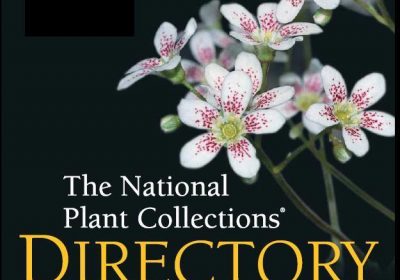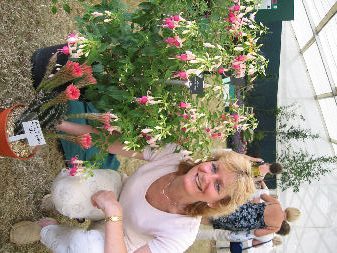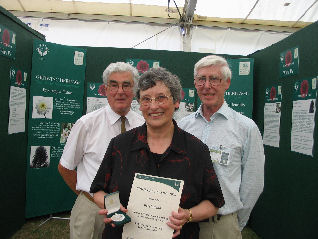TRAPS, TETRAPLOIDS, BUTTERFLIES AND BERRIES 20 NEW COLLECTIONS and TWO SCIENTIFIC AWARDS IN LATEST ROUND OF NCCPG ACCESSIONS
Description
From insect-attractors to the insectivorous: a selection of plants covering 20 genera have been added to the NCCPG’s National Plant Collection® system. Two further collections have been elevated to Scientific status through their research and education work, joining an elite of only 34 Scientific status collections amongst 660 NCCPG National Plant Collections across the UK.
New plants from as far distant as the Andes and the Himalayas are still being added to the genera collected by the two new Scientific Collection Holders, which represent Meconopsis and Fuchsia. Observations on flower colour variation within the big blue perennial poppy section of Meconopsis have been undertaken by Dr Evelyn Stevens of the Meconopsis Group in her Scottish garden: “The anthocyanins that produce colours from red to blue are sensitive to many factors such as pH, light and heat. But careful observations have made it clear that flower colour variations are not simply due to the overall soil pH. It appears probable that micro changes in the pH within the tissue cells in the flower petals are responsible for the differences in colours displayed. This whole area needs detailed scientific investigation.”
Fuchsia Research International (FRI), whose internationally-based members are involved in ethical plant-hunting trips to south America, have three Fuchsia species never before in cultivation in their collection in Swansea, including Fuchsia steyermarkii, grown from seed collected in Peru in the year 2000. “The first proto-Fuchsia appeared between 50-35 million years ago in south America,” says FRI’s Arthur Tickner. “We know the genus went across Antarctica to New Zealand and also to Australia, as its pollen has been found there.” Both Scientific collection holders are looking to the next generation of research students to take up interesting aspects of their collected genus.
A full list of the new National Plant Collections is below. Covering the unusual, the unique and the unexpected, plant notes contributed by some of our new collection holders can be found in the pages following the table.
Collection: Location: Holder & Status:
Agapanthus Hampshire Mr J Hartnell Provisional
Arbutus Gloucestershire Mr I Cathie Provisional
Buddleja davidii Devon Mrs A Allan Full
Cactaceae – Copiapoa Matacuna Turbinicarpus Cheshire North of England Zoo, Mr M Sparrow Full
Clivia Somerset Mrs S Tucker Provisional
Delphinium London Royal Parks – Regent’s Park, Mr N Biddle Full
Dionaea Essex Mr M Haslett Full
Agapanthus Hampshire Mr J Hartnell Provisional
Arbutus Gloucestershire Mr I Cathie Provisional
Buddleja davidii Devon Mrs A Allan Full
Cactaceae – Copiapoa Matacuna Turbinicarpus Cheshire North of England Zoo, Mr M Sparrow Full
Clivia Somerset Mrs S Tucker Provisional
Delphinium London Royal Parks – Regent’s Park, Mr N Biddle Full
Dionaea Essex Mr M Haslett Full
Eupatorium Flintshire Mrs J Miller Provisional
Hakonechloa Co Durham Mr & Mrs D Nichol-Brown Full
Helleborus Staffordshire Mr M Byford Full
Hosta (Tetraploid) Cheshire Mr T Saville Full
Hosta plantaginea cvs & hybrids (fragrant) Dumfries Mr J Coutts Provisional
Juglans Gloucestershire Mr I Bond Full
Malus (cider apples) Herefordshire Mr H May Provisional
Rosa – R. rugosa R. spinosissima Ayrshire Ms J Hepburn Full
Sorbus sp Cheshire Ness Botanic Garden Paul Cook Full
Tulbaghia Aberystwith, Wales Ms E Powney Full
Meconopsis Perthshire Dr E Stevens Scientific
Fuchsia Swansea, Wales Fuchsia Research International Mr A Tickner Scientific
Hakonechloa Co Durham Mr & Mrs D Nichol-Brown Full
Helleborus Staffordshire Mr M Byford Full
Hosta (Tetraploid) Cheshire Mr T Saville Full
Hosta plantaginea cvs & hybrids (fragrant) Dumfries Mr J Coutts Provisional
Juglans Gloucestershire Mr I Bond Full
Malus (cider apples) Herefordshire Mr H May Provisional
Rosa – R. rugosa R. spinosissima Ayrshire Ms J Hepburn Full
Sorbus sp Cheshire Ness Botanic Garden Paul Cook Full
Tulbaghia Aberystwith, Wales Ms E Powney Full
Meconopsis Perthshire Dr E Stevens Scientific
Fuchsia Swansea, Wales Fuchsia Research International Mr A Tickner Scientific
PLANT NOTES
FROM NEW NCCPG NATIONAL PLANT COLLECTIONS
FROM NEW NCCPG NATIONAL PLANT COLLECTIONS
Attracting pollinators in the form of butterflies has been the inspiration between two new NCCPG National Plant Collections, of Buddleja davidii and of Eupatorium. Jan Miller, new collection-holder for Eupatorium, a specialist in butterfly plants and gardens, says that butterflies are attracted to the nectar in the tubular flowers, which extends their feeding season, blooming later in the summer.
New collection holder for Buddleja davidii, Anita Allen, was first drawn to the species at a young age because of its attraction to butterflies. In 2006 she recorded the first pair of British Swallowtails to be seen outside their Norfolk habitat in her Buddleja collection garden in Devon: “They seemed to be attracted to one of the longer-flowering varieties, B. davidii ‘Gonglepod’. For anyone interested in enjoying butterflies over the longest season I would recommend B. davidii ‘Ecolonia’, a dwarf form at about 1m, extremely scented and always the first and last in flower. B. davidii variegata also has a long season. B. davidii ‘Autumn Beauty’ (syn. ‘Beijing’) flowers from August to October providing food for migrant butterflies and a food source for hibernating butterflies.” Anita also holds a Leucanthemum NCCPG collection.
New collection holder for Buddleja davidii, Anita Allen, was first drawn to the species at a young age because of its attraction to butterflies. In 2006 she recorded the first pair of British Swallowtails to be seen outside their Norfolk habitat in her Buddleja collection garden in Devon: “They seemed to be attracted to one of the longer-flowering varieties, B. davidii ‘Gonglepod’. For anyone interested in enjoying butterflies over the longest season I would recommend B. davidii ‘Ecolonia’, a dwarf form at about 1m, extremely scented and always the first and last in flower. B. davidii variegata also has a long season. B. davidii ‘Autumn Beauty’ (syn. ‘Beijing’) flowers from August to October providing food for migrant butterflies and a food source for hibernating butterflies.” Anita also holds a Leucanthemum NCCPG collection.
Mark Haslett has a new NCCPG National Collection of plants that attract a very different type of insect. His collection comprises over 70 clones and cultivars of Dionaea, the Venus Fly-Trap. Now endangered in the wild, Mark Haslett’s plants are grown from tissue culture or from seed which he collects after the plants flower from April to May. “Dionaea flower readily but produce pollen only for a very short period, so timing is everything. From seed, a mature plant will take 5 years; taking leaf cuttings or rhizome shoots is faster, they root in 4-5 weeks in sphagnum moss with the right conditions.” The largest plants in the collection are D. ‘South West Giant’, with large 1.5-2 inch traps, and there are semi-red and even totally-red clones such as D. ‘Red Sawtooth’ and D. ‘Red Pirana’. Surprisingly these plants have been known in the UK since the late 1700s when they first arrived from America.
Emitting a more pleasant fragrance are the flowers of Hosta plantaginea, the cultivars and hybrids of which form one of two Hosta collections just added to the NCCPG system. Collection-holder James Coutts describes the scent of the flowers as similar to Hyacinthus. The species is becoming much more popular with flower arrangers as both flowers and foliage can last for weeks. The plants first arrived in England in 1790 and were known as the Parisian Funkia: they had been popularised through inclusion in Josephine Bonaparte’s gardens at Malmaison.
Tetraploid Hosta are the subject of the second new collection in this genus, which belongs to Tim Saville: “Hosta produce more sports than any other genus – it’s one of their main attractions,” he comments. “The additional factors with tetraploid Hosta are the double width of variegation, the thicker leaves and sturdier flowers. The down side is that they are much more damageable if grown in a pot which has to be moved.” Removing a sport or changing pot size are the only reasons for dividing Hosta in Tim’s view: “Move a Hosta and you lose a year’s growth,” he advises.
Tetraploid Hosta are the subject of the second new collection in this genus, which belongs to Tim Saville: “Hosta produce more sports than any other genus – it’s one of their main attractions,” he comments. “The additional factors with tetraploid Hosta are the double width of variegation, the thicker leaves and sturdier flowers. The down side is that they are much more damageable if grown in a pot which has to be moved.” Removing a sport or changing pot size are the only reasons for dividing Hosta in Tim’s view: “Move a Hosta and you lose a year’s growth,” he advises.
Another genus not happy with being divided is Helleborus, according to new collection holder Mike Byford. “Division damages the plants quite badly,” he comments: “Few people realise that Helleborus are massively deep-rooted plants with a main root some 6-8 inches long. They also tolerate more sun than many people credit. They are woodland edge or meadow plants in their natural habitats and so receive full sun from October to March, until the vegetation grows around them. If you have soil that’s wet in winter then plant Helleborus under dogwoods or willows that will absorb the winter rain from the soil, leaving it pretty dry.” Mike says gardeners are missing out by not trying different species such as H. torquatus, with its extensive range of colours and markings, or H. dumetorum, which he describes as a “superb garden plant”.
Snakes and scorpions bring together our next two NCCPG National Plant Collections – Delphinium and Tulbaghia. In their native South Africa, the leaves of Tulbaghia violacea, which have a sent of garlic when bruised, can be used to help clear sinuses, or, when crushed on the skin can act as an insect repellent against mosquitoes and ticks. They are also planted around Zulu homes as a snake repellent. Other Tulbaghia species do however have a nicer side: some of their flowers are evening-scented, of cloves and incense, and a long season of flowers is offered across the various species, according to collection-holder Liz Powney.
Gerard’s Herbal mentions the seed of Larkspur (Delphinium consolida) as being useful in repelling scorpions. This could be useful to the new collection holders of Delphinium, situated in the Royal Parks at Regent’s Park, close to London Zoo. Slugs and snails however are more often the problem which Assistant Park Manager at Regent’s Park Nick Biddle remedies by using nematodes and encouraging hedgehogs. He also recommends using granular, surface-applied feed, as liquid feeds act too quickly.
Gerard’s Herbal mentions the seed of Larkspur (Delphinium consolida) as being useful in repelling scorpions. This could be useful to the new collection holders of Delphinium, situated in the Royal Parks at Regent’s Park, close to London Zoo. Slugs and snails however are more often the problem which Assistant Park Manager at Regent’s Park Nick Biddle remedies by using nematodes and encouraging hedgehogs. He also recommends using granular, surface-applied feed, as liquid feeds act too quickly.
Three new collections of Cactaceae plants are available to view inside another Zoo, the North of England Zoo near Chester. Collections of Copiapoa, Matacuna and Turbinicarpus have been assembled by Paul Shipsides as part of the zoo’s philosophy of joint plant and animal conservation. Curator of Horticulture Mark Sparrow comments: “Animal habitats include plants. The loss of habitats many mean animal extinction so it’s as important to conserve plants. At present we don’t have suitable facilities to display these plants alongside the animals but it’s something we’re looking at for the future.” The collections are currently housed in separate glasshouses.
The glasshouse plant Clivia is the subject of another new NCCPG National Plant Collection belonging to Sheila Tucker. Flowering by March, Clivia flowers have a light, delicate fragrance and the plants can flower twice each year if given a light, open growing medium and a high potash feed in March. Clivia are also easy to grow from seed, germinating readily.
The glasshouse plant Clivia is the subject of another new NCCPG National Plant Collection belonging to Sheila Tucker. Flowering by March, Clivia flowers have a light, delicate fragrance and the plants can flower twice each year if given a light, open growing medium and a high potash feed in March. Clivia are also easy to grow from seed, germinating readily.
Rosa and Sorbus, both belonging to the Rosaceae family, produce good autumn fruit. Jane Hepburn, new collection-holder for Rosa rugosa and Rosa spinosissima, feels rosehips are an important part of the garden-worthiness of these species and encourages flowering by manuring deeply both when planting and mulching. New Sorbus species with high levels of fruiting and whitish to rosy-pink fruit are coming in from China, Vietnam and Korea to the new Sorbus collection at Ness Botanic Garden, says curator Paul Cook. “Many new plants are making medium-sized shrubs, rather than trees, with good autumn colour, though the colour in the UK is not as spectacular as it is on the Chinese hillsides.” Some of the new plants have sticky large buds. Sorbus need a cool winter rest to perform to their best, and this becoming more difficult with climate change: Ness’ own weather station recorded a full one degree temperature increase across 2006.
Most of us will be familiar with the small number of Juglans species, but few can be aware of the vast number of cultivars available. Ian Bond has 141 different taxa in his NCCPG collection in Gloucestershire, which has just received Full status. He has been collecting for 20 years and has tropical species from south America, purple-leaved varieties, scrubby trees from Europe through to Asia, and even from the dry lands of Arizona a Juglans major. The latest species to be found is Juglans sigilliata, discovered in China two years ago. For fruiting purposes, and if you have the garden space, he recommends Juglans ‘Broadview’, which fruits in 3-4 years, rather than waiting 20-25 years for a Juglans regia.
From the new fruit to old, and the revival of ancient orchards in Herefordshire. Henry May of the Tidnor Wood cider orchard project has been awarded Provisional status for its Malus (cider apples) collection. It is intended to open the collection, orchards and a cider heritage centre to the public and a 17th century beam press has recently been purchased for restoration. Wildlife and grazing animals are also integral to the orchard and the Herefordshire Wildlife Trust has bat boxes amongst its trees.
From the new fruit to old, and the revival of ancient orchards in Herefordshire. Henry May of the Tidnor Wood cider orchard project has been awarded Provisional status for its Malus (cider apples) collection. It is intended to open the collection, orchards and a cider heritage centre to the public and a 17th century beam press has recently been purchased for restoration. Wildlife and grazing animals are also integral to the orchard and the Herefordshire Wildlife Trust has bat boxes amongst its trees.




